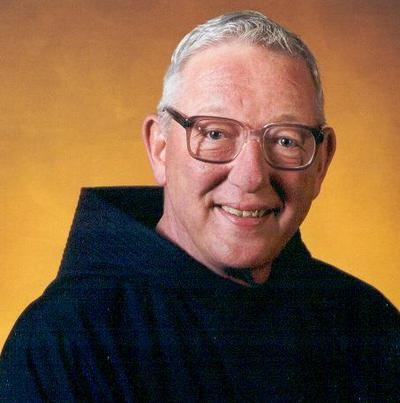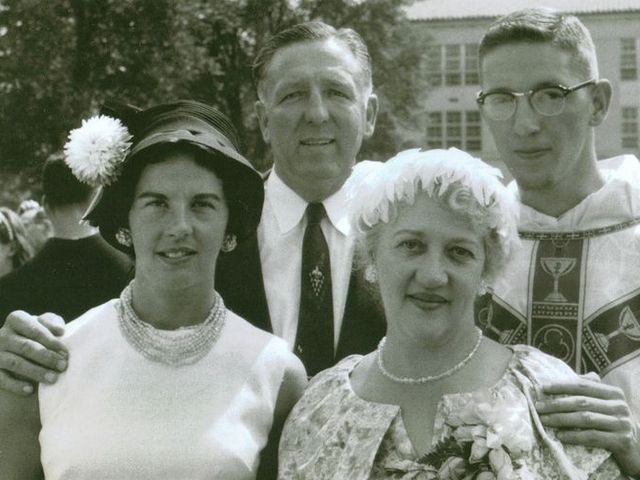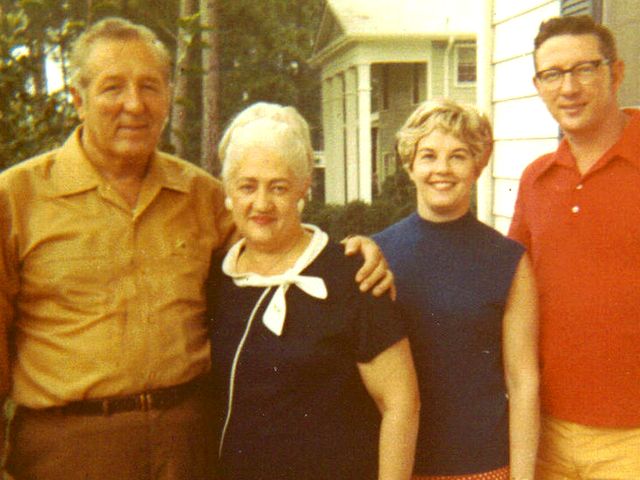 Date of Birth: November 7, 1933
Date of Birth: November 7, 1933
Place of Birth: Wilkinsburg, PA
Investiture: July 13, 1953
Temporary Profession: July 14, 1954
Perpetual Profession: July 14, 1957
Priesthood Ordination: June 6, 1959
Date of death: March 1, 2012
Burial: St. Augustine Cemetery, Millvale, PA
"Roy wasn't perfect; he had a bad slice in his golf game."
A devoted friend
Fr. Roy Schuster, OFM Cap., loved his family. He loved his friends. He loved being a Capuchin friar and loved the Province. He also loved golf.
Born to John and Mary (Wolf) Schuster on November 7, 1933, in Wilkinsburg, PA, he was given the name Robert at his baptism at St. James Church. He attended Catholic elementary schools before entering St. Fidelis High School Seminary in Herman, PA. He had heard about the Capuchins through his pastor Msgr. Stephen Walsh who had served as Vicar General of the Diocese of Pittsburgh. The parish was one where people were involved, and his parents were always ready to volunteer and lend a hand. People bonded by working together. It was a vitality that would mark the future Capuchins understanding of what it means to be a Church.
 He became a Capuchin friar at his investiture on July 13, 1953, and was given the name Roy. Making his first profession of vows in 1954, he went on to study theology in Washington, DC, where, making his perpetual profession in 1957, he was eventually ordained a deacon (1958) and then a priest (June 6, 1959). He was ordained to the priesthood at the Basilica of the Shrine of the Immaculate Conception and always considered it fortuitous that our brother Firmin Schmidt, OFM Cap, the future first bishop of the Diocese of Mendi, Papua New Guinea, preached his First Mass.
He became a Capuchin friar at his investiture on July 13, 1953, and was given the name Roy. Making his first profession of vows in 1954, he went on to study theology in Washington, DC, where, making his perpetual profession in 1957, he was eventually ordained a deacon (1958) and then a priest (June 6, 1959). He was ordained to the priesthood at the Basilica of the Shrine of the Immaculate Conception and always considered it fortuitous that our brother Firmin Schmidt, OFM Cap, the future first bishop of the Diocese of Mendi, Papua New Guinea, preached his First Mass.
Roy was a sportsman -- he loved basketball and football in his youth. His friar peers elected him to be the captain of the Capuchin basketball team, with classmates like Robert L. McCreary or John Baptist Terbovich, going head to head with their neighboring religious communities in DC. He once confessed that it was important to make people feel happy playing and dreaded having to negotiate fights and arguments. He wouldn't eat all day, he told one friar, until after a game because any tensions would upset his stomach.
For those who knew Roy, one can only smile at the irony that after his ordination, superiors asked him to pursue the study of Canon Law at Catholic University. Receiving his JCB (Bachelor in Canon Law) in 1961, he was being prepared for his work as a missionary. Somehow the personality of Roy and the study of Canon Law seem at first to be almost oxymoronic. Roy was a person of the people and always considered law taking a back seat to the pastoral care of persons in need. Perhaps knowing the law could help his attempts to adapt it and allow it to serve a living faith.
Living his dream to go to Papua New Guinea, Fr. Roy's introductory assignment in Erave prepared him to become the pastor of Queen of the Friars Minor Parish in Kagua, where he served for twelve years. You might say he was born to be a Pastor. Friends report that he had a keen mind and an intuitive sense of what would help people catch the Good News of Jesus Christ that God loved them unconditionally. He gave homilies that people would remember because they were always reflected people's experience. He had the ability to reach all levels and age groups through his creative visuals that people carried away with them to their homes and work places. He often said that religion is not to be taught but caught.
Roy loved telling jokes. It was almost a ministry with him. He believed in laughing a lot and loved to tell jokes even to perfect strangers. You'd give anything to see that glint in his eyes when he waited for you to get the punch line. He was also prone, sadly, to occasional bouts of the blahs, as he called them. Having someone to play cards with him (especially gin), to golf with him or to laugh with him was the perfect medicine for his blues.
Roy was also a man of the Second Vatican Council. His training preceded the Council, but the documents and their spirit were an impetus for and a confirmation of his missionary work. Like the "captain" he was, he wanted to empower others to share their time, their talents and their treasures for building up a parish community and to contribute to the global community in which he was so involved. People loved the ways he made celebrations of baptisms, weddings and funerals so special. Wherever he was, he became involved in Ministerial Associations and worked together with other leaders for the good of their communities. He also found great golfing partners among them.
In 1974 he was named pastor of SS. Peter & Paul Parish in Det. It was a challenge, but Roy insisted on learning the languages of the indigenous people and seldom needed a translator or catechist to interpret his preaching. His desire and ability to learn the local language of the people he served is legendary.
 Roy involved all of his friends and family to share his missionary work. In 1981, his father, a former railroad worker, learned how to weave tapestries and worked for 10 weeks to weave a 10 ft. x 7 ft. tapestry on the floor of his den. It was for the parish in Det: an intricate recreation of Leonardo DaVinci's Last Supper of 24 colors and 107,200 strands of wool ("I counted them as I went along," his father said). People would have one more beautiful reflection of being loved by people's charity, and the Last Supper could become more than just a historical event.
Roy involved all of his friends and family to share his missionary work. In 1981, his father, a former railroad worker, learned how to weave tapestries and worked for 10 weeks to weave a 10 ft. x 7 ft. tapestry on the floor of his den. It was for the parish in Det: an intricate recreation of Leonardo DaVinci's Last Supper of 24 colors and 107,200 strands of wool ("I counted them as I went along," his father said). People would have one more beautiful reflection of being loved by people's charity, and the Last Supper could become more than just a historical event.
The beauty of nature and how different the seasons appeared touched him deeply. Maybe that's why he liked to be out on a golf course. He would befriend leaders of local communities and adopt sections of the highway to keep them clean, getting groups of volunteers to be involved, of course.
One of our friars reported that Roy had about 40 outstations where he would take turns in the celebration of the Mass. Most of these bush parishes were only accessible by foot paths or motorcycle. He loved riding his bike singing at the top of his lungs and felt moved as people would joyfully come out to meet him on his arrival because they knew he would spend time with them and that the Gospel would be coming alive.
A dear friend, Sr. Kate Holohan, a Franciscan Sister of Oldenburg, IN, spoke movingly of Roy bringing communion to a man suffering from mouth cancer in a Mission outstation. The man had worked pumping water for the mission, and Roy always wanted to be sure that he received the consolation of the Blessed Sacrament. His gentleness and sensitivity to the man's pain as well as his knowledge that the Sacrament would console him helped Roy to overcome any queasiness he felt at the man's condition.
Together, Sr. Kate and Fr. Roy would be instrumental in the training of the Franciscan Sisters of Mary (FSM) which now has over 30 members from indigenous tribes. In all, Roy served twenty years as a missionary in Papua New Guinea, but it was to be his body - and his aging parents - which would compel his return to the US. His years as an athlete were not good to his knees, and his missionary walks to outposts had taken their toll.
Roy returned to the US in 1981 and was more than reticent to begin "all over again." He feared that the communities in the States were radically different from the country he had left behind and that his talents would not be appreciated. He served as an Assistant Pastor in Dover, OH, and slowly adjusted to the culture and Church he had left in 1963, dramatically changed through the decades of the '60s and '70s. But our brother was way ahead of the game.
Roy was given permission to make a sabbatical offered at Notre Dame University. It was a time for adjustment from the mission field to American parochial life. There were 40 priests in the program, 20 from the missions and 20 American pastors. Discussion times and recreational times (did someone say golf ?) bolstered Roy's confidence. He was ready to pastor again.
In 1985, Roy was assigned to St. Anthony Parish in Charleston, WV, where people testify to his bringing the parish to life. A parishioner wrote of his work in 1992:
"I am extremely impressed by the ways in which Fr. Roy keeps our parish vital. The parish has not only successfully continued existing ministries, but has expanded into many new areas . . . Fr. Roy has consistently, through an active RCIA process, brought some 8-10 new adults into the Church [every year]. Many parishioners have become increasingly involved in a new ministry to the homeless by preparing and serving meals at the local Men’s shelter. The parish sewing circle has begun a program to make hand-made quilted teddy bears to distribute to the sick children in the area. We have reactivated our youth group and are consistently getting an attendance of 15-20 teenagers at the events. Fr. Roy has also substantially increased lay participation in the Mass by increasing the numbers of lectors and Eucharistic minister . . . The parishioners are exceedingly fond of Fr. Roy."
Both in 1985 and in 1996, Roy had to undergo surgery for his knees. They allowed him to work with less pain, though they never stopped him from moving out to his parishes and his friends. As his parents, John and Mary, aged, Roy took them under his care, never allowing them to become isolated or feel abandoned. Roy’s van, with enough space for wheelchairs, were a regular presence at Provincial events, and as Fr. Roy accepted a pastorate in Conway, PA, his parents moved nearby. They would joke about their weaknesses, and there was always time for the regular gin game with them. His dad passed away in 1995 (at 88) and his mother would follow in 2002 (at 95), and Roy felt the absence in profound ways.
Roy’s pastoral fervor hadn't diminished, even if his physical energy did. He authored Stations of the Cross for young people. He had a special love of reconciling divorced and remarried couples to the Church, and he gave special care to the children in CCD. He once confronted a local bishop on the latter’s preferential treatment of parochial school students. The CCD program of Fr. Roy’s parish had far more students than any of the area’s Catholic schools – and he believed funding should reflect that. Fellow clergy cringed at his boldness, but they admired his conviction.
Roy was happy to return to West Virginia in 2001, taking the pastoral charge of smaller and less active parishes. Serving the people of Coalton (2001-2002) and Elkview (2002-2009), he asked for retirement at the age of 76. He continued to live in the friar in Charleston, WV, cherishing his independence and his friendships forged there. As he became more isolated, while he felt relieved from the tensions of the ministry, he was prone to feeling less needed and less appreciated. It was always the phone call to a friend or a chance to share a humorous story that could still bring a smile to his face.
Fr. Roy died in his room at the friary sometime in the early morning of March 1, 2012; he would bear his transitus alone, but his great faith in the Communion of the Saints and in the lasting value of family and friendships assures us he was not without supportive companions and family for long .
Visitation and viewing took place at St. Anthony Church on Sunday, March 4, 1012 with a Vigil service celebrated in the evening. The Mass of Christian Burial was celebrated the following morning, Monday, March 5, and his classmate and lifelong friend, Fr. Robert McCreary, OFM Cap., offered the funeral homily. The church was filled with the many parishioners whose lives he touched.
On Tuesday, March 6, Father Roy's remains were transported to St. Augustine Cemetery in Millvale (Pittsburgh) PA, for graveside prayers and committal, where our brother was buried in a plot among his confreres.
We pray that Fr. Roy receive the rest he yearned for in the communion of God's people. May the eternal knowledge of God's goodness and love be an eternal joy. Besides, why not suppose that Roy Schuster too was finally "caught up" in the Love through Whom he would "catch" so many others?
